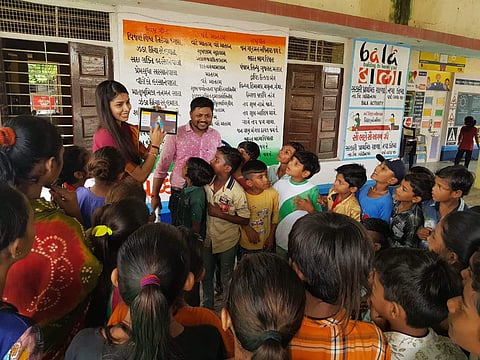

School textbooks are good to learn lessons from but interactive videos are an added advantage for kids to really understand the concepts, opines Hrushikesh Behera, Director of Senscilen, a start-up that's been incubated at Entrepreneurship Development Institute of India (EDII) since last year. Hrushikesh and his friend Ganesh Adapa came up with the idea of creating 3D interactive videos for school students. But what led them to this unique idea in the first place is an interesting story. Both Hrushikesh and Ganesh have different educational backgrounds. A few years ago, they crossed paths at an EdTech company that produced videos for school children. "Up until a few years ago, I worked in the education sector as a lecturer in an engineering college. After that, I joined an EdTech company to provide content for educational videos. During this phase, I felt that videos must not be merely meant for watching. Children must be able to interact with these videos and understand the concept. Even in classrooms, students are just spectators and the teacher goes on teaching. They are not sure of whether the kids have understood or not. Since, we see everything around us in 3D format, our brain can understand concepts quickly only when they are in 3D format. Therefore, I decided to come up with the content and software that can help us produce 3D videos. This Senscilen was born in January 2019," says Hrushikesh, who has an MSc degree from NIT Rourkela.
At this point, Hrushikesh expressed the same idea to Ganesh as he felt that he was the right person to help him develop these videos. "I think education is the area where technology can be used the most. By using the 3D interactive videos or models, children can see and learn," says Ganesh, who is a Computer Science graduate from Jawaharlal Nehru Technological University and has worked for eight years as a senior Unity3D developer. The duo would spend extra time after office hours researching and designing the 3D interactive videos. While they were ready with their product, they faced challenges in expanding their team and finding a place to work out of. "Having our own space to work with our team was one of the primary challenges. So, we started looking out for programmes like Start-Up India. I got to know about the annual meet that EDII's CrAdLE conducts to host different start-ups. When we approached Mayank Patel, CrAdLE's CEO, he asked us to give a demo of our product. He sensed that our product has potential and was ready to provide space and support with funding," Hrushikesh adds.
Hrushikesh and Ganesh wanted to produce 3D videos for all subjects. However, they were shocked to find out that only 15% and 6% of children could achieve more than 50% marks in Science and Mathematics respectively in class VIII [as per Gujarat government data (2017-18)]. So, they decided to develop video content initially for class VI Science. "We have converted most of the lessons in the class VI NCERT Science textbooks to videos. Last month, we started developing videos for class VII and VIII Science. We will be completing these videos soon so that students can access them from the coming academic year. All these videos are available in the Senscilen app. This app can be downloaded on both Android and iOS-based tablets," says Hrushikesh.
The speciality of their videos is that their 3D e-learning interactive educational content can be viewed in the form of Augmented Reality as well as Virtual Reality. For example, if you are studying the anatomy of the human body, you can view the complete 3D model of a skeleton. In case a student is confused about the number of bones in the ribcage, then the skeleton can be turned in 360-degree angle and viewed. They can also view the same model through Virtual Reality. It appears as if the model is placed right infront of you. At the end of every chapter, there are questions that every child must answer to proceed to the next concept or lesson. "We will soon be developing these videos with audio in different languages. Once we complete the NCERT syllabus, we will be able to do the same for IGCSE syllabus too. And the same goes for competitive exams like JEE, CET and others," he concludes.
